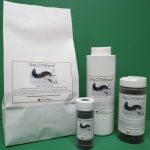General
Dalotia coriaria (formerly known as Atheta coriaria) is a predatory rove beetle that lives mostly in the top half inch of soil. They will eat a wide variety of prey, but for greenhouse use, they are mainly utilized for the prevention, control, and management of fungus gnats (Sciaridae), shore flies (Scatella spp. and Ephydridae spp.), and certain thrips species that pupate in soil/on the ground. Like Stratiolaelaps scimitus, their affinity for eating thrips pupae is an underrated benefit they bring to biocontrol programs. Breaking that part of a thrips life cycle has a substantial impact on their overall population.

The adult beetles are very mobile. They will crawl or fly from pot to pot, and from one area of the greenhouse to another, eating pests all along the way. This makes them effective even in hydroponic greenhouses with no soil. For these situations, breeding boxes are highly recommended since broadcasting them on rockwool is relatively ineffective at establishing populations. Even in traditional greenhouses with soil, the breeding boxes can be a great supplement to (but not replacement for) broadcasting on the soil, especially if the facility has dirt or gravel floors.
Description
Adults are black, slender, between 3-4 mm long, and resemble tiny earwigs more than beetles. Their elytra (leathery hind wings) are truncated, meaning they stop around a quarter of the way down their body, which is a characteristic that all rove beetles share. They are able to fold their membranous wings (the ones used for flight) under their elytra by using their abdomens. To see this in action, go to this website https://www.pnas.org/content/early/2014/10/30/1409468111/tab-figures-data.
Larvae look quite different than the adults, although they have the same basic shape. They are yellow, have six legs towards the front of their bodies, and short antennae. The legs and antennae can distinguish them from other worm-like organisms in the soil.
Life History
Females lay around 90 eggs, of which about 70 make it to adulthood1. At 26°C, eggs take just over two days to hatch, larvae live around seven days before pupating, and pupation takes just under 8 days; so from egg to adult takes approximately 17 days1. Adult females live approximately 48 days, whereas males around 601. Since they spend more of their time in the soil, ambient air temperatures are less important for them compared to other biological control agents. They can survive the winter by going deeper into the soil, even in areas where temperatures fall well below freezing.
Benefits
In the proper conditions, Dalotia can establish quickly in greenhouses and other growing facilities. Their propensity to explore and look for food sources makes them a valuable resource to almost any biological control program. Because of their mobility they can be used in hydroponic grows, but again, if there is no soil in the facility, breeding boxes are highly recommended. They also are a tremendous help with any facility that has dirt or gravel floors, since soil pests are often found there. Dalotia do not diapause in low light levels and are active year-round.
Drawbacks
While they can and should be used in most hemp/cannabis grows, overpopulation of Dalotia can result in them climbing the plants and getting stuck to the buds in flower. This is one of the only situations where there can be too many biocontrol agents of any kind. Do not use higher than the recommended rate of Dalotia in hemp/cannabis and keep a close eye on the population.
Scouting
Keep in mind that they are mostly nocturnal, but they can sometimes be found running around during the day. They’re often found on the soil surface or rockwool, or even climbing the walls of the facility. If populations are especially high, they can also be counted on sticky cards. Sometimes they can be found taking shelter underneath rocks or other objects. The potato test is also viable for them, as it is for Stratiolaelaps scimitus. Place a slice of potato in the soil, and this will attract both fungus gnat larvae and their predators. Dalotia can sometimes be found on or near the potato slice after a couple/few days.
Usages
Greenhouses, gardens, interiorscapes, ornamentals, covered crops, and mushrooms.
Release Rates
In most situations, use a rate of 0.2 Dalotia per square foot. Only calculate the soil surface area, since that’s where they live. If the crop is transplanted, release Dalotia again but at only half the rate. For hotspots, use up to 1 per square foot.
Produced in the USA by Beneficial Insectary!
Purchase
References
1) Wilson, E.R.E, 2012 Life cycle of the rove beetle, Atheta coriaria (Kraatz) (Coleoptera: Staphylinidae) and suitability as a biological control agent against the fungus gnat, Bradysia sp. nr. coprophila (Lintner). PhD Dissertation Kansas State University.
2) Jandricic SE, Scott-Dupree CD, Broadbent AB, Harris CR, Murphy G. 2006. Compatibility of Atheta coriaria with other biological control agents and reduced-risk pesticides used in greenhouse floriculture IPM programs for fungus gnats. The Canadian Entomologist 138: 712-722.

